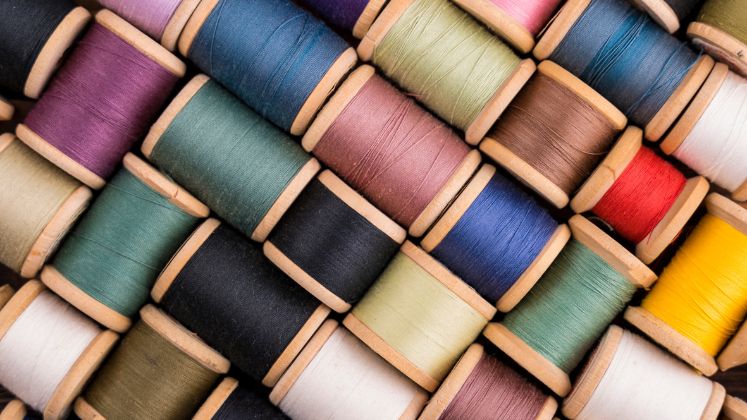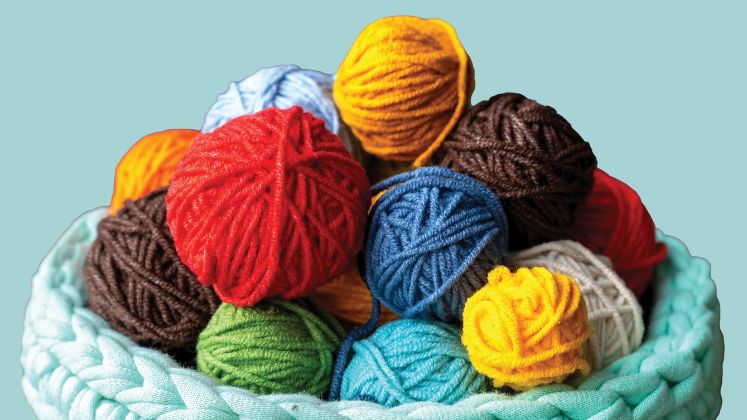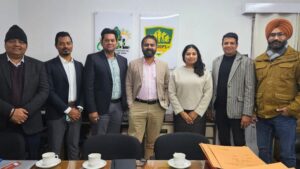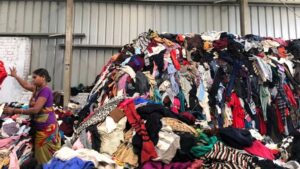The International Monetary Fund (IMF) has raised its 2024 global growth projection to 3.1 per cent, citing unexpected ‘resilience’ in major economies worldwide. This 0.2 percentage point increase from the previous estimate indicates a strong trend continuing into 2024, not just in the US but globally. Capitalising on this momentum, the Indian fabric and yarn industry is primed for growth, bolstered by enhanced infrastructure, raw material self-sufficiency, a strong presence throughout the production process and renewed emphasis on innovation and market access. Based in Madhya Pradesh, Sagar Manufacturers exports to over 20 countries and collaborates with 200+ global brands. With a daily production capacity of approximately 150 tonnes of polyester cotton yarn and a 2.5 lakh spindle installed capacity, the company is preparing for a spinning expansion alongside launching a process outsourcing service for grading knitted fabric processing data. “This initiative will enhance our processing capacity to approximately 600 to 700 tonnes per month, accommodating various types of knitted fabrics. Currently focused on greige fabrics, we will soon venture into processing finished fabrics as well,” said Siddharth Sudhir Agrawal, Managing Director, Sagar Group, a family-owned conglomerate with interests in education, textiles, food processing, real estate and healthcare. The Group ventured into yarn manufacturing in 2012 under the brand name Sagar Manufacturers Pvt. Ltd.
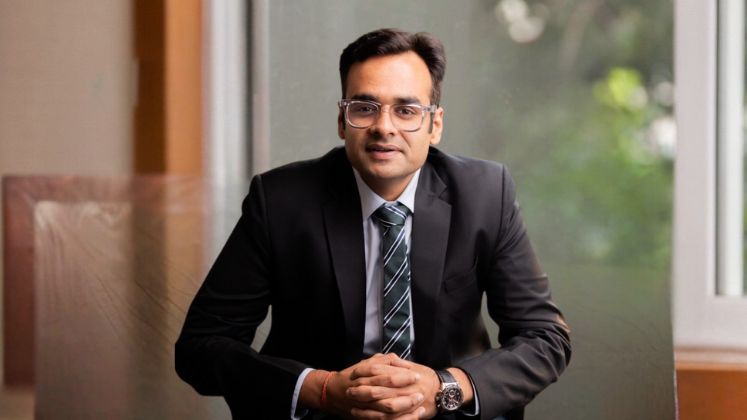
The company maintains a strong foothold in both domestic and export markets. It sources cotton from various states known for cotton cultivation in India. Procurement from the northern regions includes Rajasthan, Haryana and Punjab, while Gujarat and Maharashtra in the West contribute to its cotton supply. Karnataka and Andhra Pradesh are identified as key sources in the southern regions. Additionally, cotton is imported from Australia to complement domestic procurement. In terms of fibre, polyester is a significant component in its products.
“The textile market has faced significant challenges over the past one-and-a-half to two years, largely due to geopolitical crises. However, thanks to strong domestic demand in India, most businesses have managed to weather the storm and remain resilient. Looking ahead, we remain optimistic that conditions will improve in the foreseeable future,” said Siddharth.
Sharing similar optimism, D. Rajarathinavelu, Sales Manager, Amarjothi Spinning Mills Ltd., which produces colour melange yarn for hosiery, woven and home textiles, stated, “The last couple of months have shown improvement compared to the previous year, with a gradual uptick in activity. We remain optimistic that this trend will continue into 2024 and beyond.” Its extensive product portfolio includes Cotton Melange Yarn, Viscose Melange Yarn, Polyester Melange yarn, Slub Melange Yarn, NEPS Melange Yarn, Fancy Melange Yarn, Grindle Melange Yarn, Cut Thread Melange Yarn. Amongst its clientele are prominent global brands such as Adidas, Levi’s Lifestyle, H&M, Burton Menswear London, JCPenney, Walmart, Kappa, Gap, Puma, U.S. Polo Assn, Van Heusen and domestic brands like Zudio and Westside. Moreover, the company has a manufacturing capacity of 60,000 kilos of yarns per day and it boasts an annual revenue of Rs.300 crore.
“Whatever dip we experienced has already occurred, I foresee an uptick in demand and better realisations in the upcoming months,” said Mikesh Dattani, Director, Sanathan Textiles Ltd., one of India’s leading yarn manufacturers engaged in the production and export of Polyester Filament Yarn, High Tenacity Filament Yarn, Aiirtex Yarns, Polyester Filament Twisted Yarns and Cotton. Currently, 80 per cent of its production caters to the domestic market. It has a capacity of over two lakh tonnes of filament yarn, nearly 15,000 tonnes of cotton yarn and approximately 9,000 tonnes of technical textiles.
He added, “India’s apparel sector is experiencing significant growth, attracting major players seeking to source their products from us. This growth spans across various categories including suiting, shirting, athleisure, ladies dress materials and hosiery knits. Notably, in the knitwear segment, there’s a prominent shift from cotton to filament yarn due to cost considerations, as cotton is approximately three times more expensive than filament yarn.”
“Around five years ago, our export-to-domestic ratio stood at 30 per cent to 70 per cent, whereas today, it has shifted significantly to nearly 90 per cent domestic. This shift is largely due to challenges in the export market. Nevertheless, I am confident that the European markets too will experience a robust resurgence in the near future,” said Ravi Taparia, Vice President – Yarn Marketing, NSL Textiles, a part of multi-dimensional NSL Group, which is a fully integrated textile company with 7000 workforce in Andhra Pradesh.
Seeds have been the company’s primary focus and this year marks its 50th anniversary in the seed industry. The company claims that it is India’s second-largest seed company overall and the largest for cotton seeds specifically. Presently, it operates around 240,000 spindles, resulting in nearly 70 tonnes of daily production.
“For the next two or three years, we have sufficient capacity. However, we anticipate an increase in demand going forward,” claimed Dinesh Keswani, Director of Business Development and Technical at Hyosung India, part of Hyosung Corporation, a global leader in spandex and elastane production offering stretch fabrics for various applications, such as apparel, denim, sportswear, innerwear and technical textiles having an annual capacity of 40-45 thousand metric tonnes.
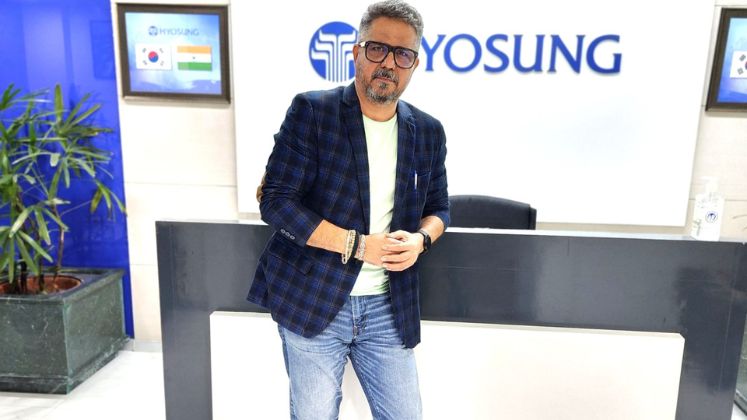
| US $ 45 million
India’s trade with Latin America amounted to US $ 45 billion in 2021-22 and is expected to soar to US $ 100 billion within the next five years. Colombia’s fashion industry alone contributes nearly 10 per cent to the country’s industrial GDP. |
Growth strategies
In the manufacturing world, it’s often a rollercoaster ride of highs and lows. One moment, you’re inundated with orders, working tirelessly to meet demands, and the next, you’re struggling to secure enough orders to sustain operations. The key to resilient business lies in diversification. Even during periods of stability, it’s essential to diversify your client base and product offerings.
“It’s essential to recognise that no market remains consistently lucrative; fluctuations are inevitable. Therefore, we strategically manage our operations to ensure that all markets remain vibrant. This approach enables us to navigate through challenging times and redirect our focus towards more promising opportunities,” noted Siddharth.
He said that amongst the regions presenting promising export opportunities, Latin America emerges as a standout.
India’s trade with Latin America amounted to US $ 45 billion in 2021-22 and is expected to soar to US $ 100 billion within the next five years. For instance, Colombia’s fashion industry alone contributes nearly 10 per cent to the country’s industrial GDP and provides employment to approximately 600,000 individuals.
“Latin America has historically been a significant destination for Indian exports. Although there was a decline in consumption capacity in the region recently, we observe signs of revival. Our business also extends to supplying to Peru and Colombia, underscoring the importance of Latin America in our market strategy,” explained Siddharth.
Manufacturers, especially those of mid-sized companies, should redirect their focus towards targeting niche segments and specialised products, opined Vasudev D Jhanwar, Managing Director of The Ram Krishna Group, based in Ichalkaranji which has an annual turnover of around Rs.200 crore and has an annual capacity of 20 million metres. The group specialises in fabric production, with an extensive portfolio that includes Cotton, Cotton Poly, Linens, Modals, Viscose, Excels, Polyester, Tencel and Simple Cotton.

| Unlike China, which may not prioritise orders for smaller quantities, or Bangladesh, which may not find 5000 pieces significant, our specialisation in catering to such orders holds significant value. Moreover, margins are typically lower in mass production. For example, earning a profit of Rs. 2 crore with a turnover of Rs.1000 crore is less burdensome compared to achieving the same profit with a turnover of Rs.200 crore. Ultimately, profitability is the goal for everyone.” Vasudev D Jhanwar Managing Director, The Ram Krishna Group |
While other countries excel in producing mass commodities, India distinguishes itself as the go-to destination for specialised products. “Unlike China, which may not prioritise orders for smaller quantities, or Bangladesh, which may not find 5000 pieces significant, our specialisation in catering to such orders holds significant value. Moreover, margins are typically lower in mass production. For example, earning a profit of Rs. 2 crore with a turnover of Rs.1000 crore is less burdensome compared to achieving the same profit with a turnover of Rs.200 crore. Ultimately, profitability is the goal for everyone,” said Vasudev.
He stressed that with niche products, there’s potential for growth and sustainable survival. Moreover, they justify higher prices and let you position your products as premium, particularly if no competitors offer similar products.
Industry players also called for more focus on value addition in order to sustain and further enhance their global competitiveness.
“Whether its cotton, technical textiles, or filament yarns, our emphasis lies in offering value-added and specialty yarns. For instance, in filament yarns, nearly half of our products are value-added offerings, while in cotton yarns, we specialise in super fine yarns. Our commodity business represents only a small fraction of our overall operations,” argued Mikesh.
Mikesh further averred, “We add lycra to the yarn stage, a process often used by denim manufacturers. These value-added yarns are typically made-to-order (MTO), allowing for customised batches ranging from 5 to 50 tonnes. Banswara Syntex Ltd., a vertically integrated textile mill, has been purchasing a particular shade from us for over a decade. Companies like Decathlon have specific requirements for water-absorbent yarns, which we provide at the yarn stage, eliminating the need for post-weaving treatments on their end. Furthermore, in technical textiles, we are expanding into dope dyes.”
The advantages are significant. Processing costs at the apparel stage are typically higher than those at the yarn stage, resulting in cost savings. Additionally, the time consumption is reduced.
Focus on sustainability
Looking ahead, sustainability is essential for survival in the market. “Major brands like Target, C&A, Primark and Walmart are emphasising sustainability initiatives. Primark, for instance, as part of its shift to using recycled and more sustainably sourced materials in its clothing, has made a commitment that 100 per cent of the cotton in its clothes will be organic, recycled or sourced from Primark Sustainable Cotton Program (aiming to reduce the environmental impact of cotton and supporting the livelihoods of cotton farmers) by 2027. Target, on the other hand, prioritises suppliers with Higg Index ratings. Meeting these new buyer requirements poses a challenge for the industry,” opined Vasudev.
Highlighting the sustainable efforts of NSL Textiles, Ravi mentioned they are a fully integrated company capable of providing information from seed to end product. “Through our innovative cotton collaborative farming initiative, we engage with farmers from seed supply to crop maintenance and purchase back. This approach ensures the preservation of our developed seed varieties and enables us to produce pure cotton yarns. With our own ginning facilities in place, we manage the entire process seamlessly, from seed to garment, ensuring quality and transparency every step of the way.”
To increase the cotton yield, NSL is providing farmers with seeds which have been developed to promote vertical growth instead of horizontal. This means that instead of requiring a spacing of one-and-a-half metres between rows, now less than a metre is needed. With this change, farmers can plant more rows in the same field, automatically increasing their yield. Moreover, the quality of the seeds has improved, resulting in bulkier cotton fibres. “We expect a significant increase in yield, potentially up to 30 per cent, which would make a substantial difference for farmers,” noted Ravi.
The sustainable fashion market in India is forecasted to expand at a compound annual growth rate (CAGR) of 10.6 per cent from 2021 to 2026, as per a report. Plant-based natural fibres like hemp, banana, jute, bamboo, sisal, coir, pineapple, ramie, lotus amongst others are driving this growth. Hemp, in particular, is gaining significant traction in India across major brands and start-ups alike.
“There’s a genuine demand for hemp due to its sustainability benefits. Hemp is naturally resistant to pests, eliminating the need for fungicides or pesticides. However, it’s a regulated market due to its association with the cannabis plant, which poses challenges,” said Siddharth Mehta, Managing Partner at Texventures Pvt. Ltd., which represents one of the world’s major linen and hemp yarn spinners, KINGDOM Holdings Limited, Hong Kong. KINGDOM has a capacity of 25,000 tonnes of 100 per cent linen yarn and 2,000 tonnes of 100 per cent hemp yarn per annum. Its clients include Arvind, Vrijesh Natural Fiber and Fabrics (India) Pvt. Ltd., Raymond and Burgoyne amongst others.
Currently, Siddharth stated that Indian hemp fibres are primarily suitable for coarser count yarns, mainly used in the home furnishing sector for items such as carpets and curtains. However, to enter the mainstream apparel market, higher quality fibres are required, which are not currently feasible in India due to the challenging extraction process and lack of R&D investment. China has mastered fibre extraction over the past decade with KINGDOM starting to sell in India around 2020. India is still in the R&D phase, primarily utilising hemp fibres in blended yarns rather than pure hemp.
“We’re currently offering two blends: cotton blend and tensile blend, both containing 55 per cent hemp—a unique offering that sets us apart globally. European hemp fibre, like the Marmara hemp, has also entered the market, but it’s typically suitable for blends containing up to 30 per cent hemp. The challenge lies in spinning 100 per cent hemp yarn, which even European producers are grappling with.”
“Despite this, the market is steadily growing, with new brands and start-ups expressing interest in investing in hemp,” added Siddharth.
He further stated, “Muji, a Japanese retailer offering a diverse range of household and consumer goods, has secured a deal for a year’s supply of hemp yarns with KINGDOM. This partnership means that Muji alone accounts for 50 per cent of our hemp production. Even, Levi’s is collaborating with KINGDOM to expand the range of fabrics made from hemp. Furthermore, we are also collaborating with Arvind in India,” emphasised Siddharth.

